电气工程及其自动化专业英语
电气工程及其自动化专业英语(语法部分)
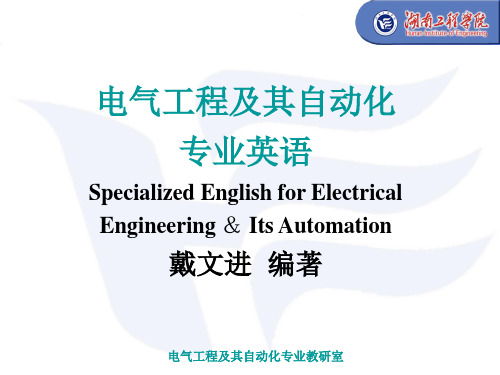
Specialized English for Electrical Engineering & Its Automation
戴文进 编著
电气工程及其自动化专业教研室
Introduction
• 1 Importance
• 2 Purpose Train students’ comprehension and application ability to
• 另外,专业词汇的词义普遍比较单一,词汇中前 缀和后缀出现的频率很高,缩略语使用的比较多。
电气工程及其自动化专业教研室
词汇的分类( lexical classification)
1 技术词汇(special technical words )---某个专业所特有的词汇,如 diode, substation,autotransformer,superconductivity.
Application, implementation
电气工程及其自动化专业教研室
词汇的构成( words constitution)
专业词汇构成的特征(1)有50%以上的专业词汇来 自外来语;(2)广泛地使用构词法;(3)常用词汇专业化. 1合成法( composition)
horsepower, push-pull, power utilization 2 转换法(conversion)
• Other characteristic, such as frequency, wave shape, and phase balance are seldom recognized by the consumers, but are given constant attention by electric power utility engineers.
电气工程及其自动化专业英语第一章课文翻译
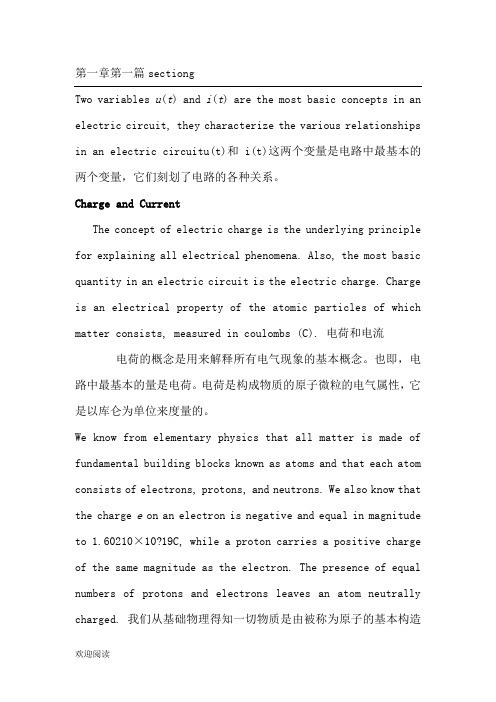
第一章第一篇sectiongTwo variables u(t) and i(t) are the most basic concepts in an electric circuit, they characterize the various relationships in an electric circuitu(t)和i(t)这两个变量是电路中最基本的两个变量,它们刻划了电路的各种关系。
the charge e on an electron is negative and equal in magnitude to 1.60210×10 19C, while a proton carries a positive charge of the same magnitude as the electron. The presence of equal numbers of protons and electrons leaves an atom neutrally charged. 我们从基础物理得知一切物质是由被称为原子的基本构造部分组成的,并且每个原子是由电子,质子和中子组成的。
我们还知道电子的电量是负的并且在数值上等于 1.602100×10-12C,而质子所带的正电量在数值上与电子相等。
质子和电子数量相同使得原子呈现电中性。
We consider the flow of electric charges. A unique feature offlow of negative charges, as Fig.l-1 illustrates. This convention was introduced by Benjamin Franklin (l706~l790), the American scientist and inventor. Although we now know that current in metallic conductors is due to negatively charged electrons, we will follow the universally accepted conventionthat current is the net flow of positive charges. Thus, Electriccurrent is the time rate of charge, measured in amperes (A).Mathematically, the relationship among current i , charge q , andtime t is 当我们把一根导线连接到某一电池上时(一种电动势源),电荷被外力驱使移动;正电荷朝一个方向移动而负电荷朝相反的方向time in several ways that may be represented by different kindsof mathematical functions 我们通过方程(1-1)定义电流的方式表明电流不必是一个恒值函数,电荷可以不同的方式随时间而变化,这些不同的方式可用各种数学函数表达出来。
电气工程及其自动化专业英语答案

第一章⚫Section1习题答案一.Choose the best answer into the blank1.B2.D3.C4.A5.B二.Answer the following questions according to the text1.No. The current need not be a constant-valued function because charge can vary with2.Time.2.The current increases when the time rate of charges is greater.3.The uab=-1V can be interpreted in two ways:①point b is 1 V higher than point a;②the Potential at point a with respect to point b is -1V.4.w=∫pdt5.Because by the passive sign convention,current enters through the positive polarity ofThe voltage,p=ui>0 implies that the element is absorbing power and p=ui<0 impliesThat the element is releasing or supplying power.⚫Section2习题答案一.Choose the best answer into the blank1.B2.A3.B4.C5.B二.Answer the following questions according to the text1.The difference between an independent source and a dependent source is: the source2.Quantity of a dependent source is controlled by another voltage or current,but the source Quantity of an independent source maintains a specified value.3.An ideal independent source is an active element that provides a specified voltage or4.Current that is completely independent of other circuit variables.3.No.The current through an independent voltage source can be calculated by the4.External circuit.4.A voltage-controlled voltage source(VCVS),A current-controlled voltage source (CCVS),A voltage-controlled current source (VCCS), A current-controlled current source (CCCS)5.No,it isn’t.三.Translate the following into Chinese(译文)在随后内容中提及的所有简单电路元件,根据通过它的电流和其两端电压之间的关系进行分类。
电气工程及其自动化专业英语 Chapter 6 Electric Power Systems
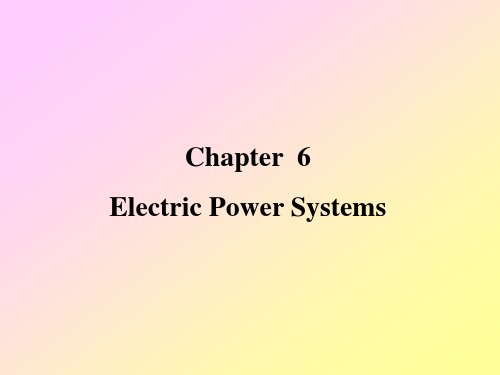
Section 1 Introduction
to acceptable levels, voltage levels had to be high for long-distance power transmission. Such high voltages were not acceptable for generation and consumption of power; therefore, a convenient means for voltage transformation became a necessity. The development of the transformer and AC transmission by L. Gaulard and J.D. Gibbs of Paris, France, led to AC electric power systems. In 1889, the first AC transmission line in North America was put into operation in Oregon between Willamette
Section 1 Introduction
The first complete electric power system (comprising a generator, cable, fuse, meter, and loads) was built by Thomas Edison – the historic Pearl Street Station in New York City which began operation in September 1882. This was a DC system consisting of a steam-engine-driven DC generator supplying power to 59 customers within an area roughly 1.5 km in radius. The load, which consisted entirely of incandescent lamps, was supplied at 110 V through an underground cable system. Within a few years similar systems were in
电气工程及其自动化专业英语介绍
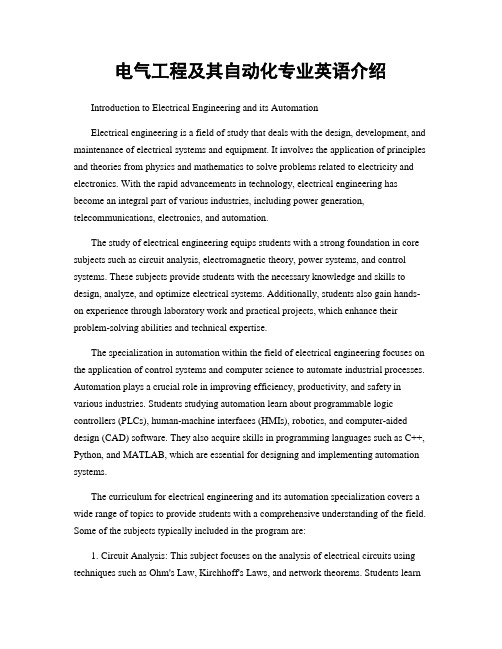
电气工程及其自动化专业英语介绍Introduction to Electrical Engineering and its AutomationElectrical engineering is a field of study that deals with the design, development, and maintenance of electrical systems and equipment. It involves the application of principles and theories from physics and mathematics to solve problems related to electricity and electronics. With the rapid advancements in technology, electrical engineering has become an integral part of various industries, including power generation, telecommunications, electronics, and automation.The study of electrical engineering equips students with a strong foundation in core subjects such as circuit analysis, electromagnetic theory, power systems, and control systems. These subjects provide students with the necessary knowledge and skills to design, analyze, and optimize electrical systems. Additionally, students also gain hands-on experience through laboratory work and practical projects, which enhance their problem-solving abilities and technical expertise.The specialization in automation within the field of electrical engineering focuses on the application of control systems and computer science to automate industrial processes. Automation plays a crucial role in improving efficiency, productivity, and safety in various industries. Students studying automation learn about programmable logic controllers (PLCs), human-machine interfaces (HMIs), robotics, and computer-aided design (CAD) software. They also acquire skills in programming languages such as C++, Python, and MATLAB, which are essential for designing and implementing automation systems.The curriculum for electrical engineering and its automation specialization covers a wide range of topics to provide students with a comprehensive understanding of the field. Some of the subjects typically included in the program are:1. Circuit Analysis: This subject focuses on the analysis of electrical circuits using techniques such as Ohm's Law, Kirchhoff's Laws, and network theorems. Students learnto analyze and solve complex circuits to determine voltage, current, and power distributions.2. Electromagnetic Theory: This subject deals with the study of electromagnetic fields and their interactions with electrical systems. Students learn about Maxwell's equations, electromagnetic wave propagation, and the behavior of electromagnetic devices such as transformers and motors.3. Power Systems: This subject covers the generation, transmission, and distribution of electrical power. Students learn about power generation technologies, power system components, and the design of electrical grids. They also study power system protection and control to ensure the reliable operation of power networks.4. Control Systems: This subject focuses on the analysis and design of control systems to regulate and optimize the behavior of dynamic systems. Students learn about feedback control, PID controllers, stability analysis, and system modeling. They also gain practical experience in designing and implementing control systems through laboratory experiments.5. Digital Electronics: This subject introduces students to the fundamentals of digital logic circuits and systems. They learn about Boolean algebra, logic gates, flip-flops, and sequential logic. Students also gain hands-on experience in designing and testing digital circuits using simulation software and hardware components.6. Automation and Robotics: This subject explores the principles and applications of automation and robotics in industrial processes. Students learn about industrial automation technologies, robotic manipulators, and sensor integration. They also study topics such as motion planning, trajectory control, and machine vision.7. Computer Programming: This subject provides students with the necessary programming skills to develop software for electrical engineering applications. Students learn programming languages such as C++, Python, and MATLAB. They also gain experience in algorithm development, data analysis, and simulation techniques.Upon graduation, students with a degree in electrical engineering and its automation specialization have excellent career prospects. They can work in various industries, including power generation companies, telecommunications firms, manufacturing companies, and automation solution providers. Job roles for electrical engineering graduates include electrical design engineer, control systems engineer, automation engineer, power systems engineer, and research scientist.In conclusion, electrical engineering and its automation specialization offer students a comprehensive understanding of electrical systems and their automation. The program equips students with theoretical knowledge, practical skills, and programming expertise to design, analyze, and optimize electrical systems. With the increasing demand for automation in various industries, graduates in this field have promising career opportunities.。
(最新整理)(完整版)电气工程及其自动化专业英语

电气工程及其自动化专业教研室
6
• The exciting or magnetizing current (励磁电流)can thus be very small. Further, the proportion of the total flux which is linked mutually by the two coils is greatly increased.
of two coils in close proximity. One coil of N1 turns is excited with
alternating current and therefore establishes a flux φ11 which alternates with the current (随时间交变). The other coil is linked
• the applied voltage 外施电压
• zero-power-factor 零功率因数
• the no-load power factor 空载功率因数
• formulate 用公式表示,系统地阐述
• saturation 饱和
2021/7/26
电气工程及其自动化专业教研室
4
Unit 11 The Transformer on No Load
a result (因此), is called the secondary winding.
2021/7/26
电气工程及其自动化专业教研室
7
• It should not be difficult to realize that the two functions are interchangeable: if coil 2 were excited instead, a mutual e.m.f. would be induced in coil 1 which would then become the secondary winding(二次绕组).
《电气工程及其自动化》专业英语夹带
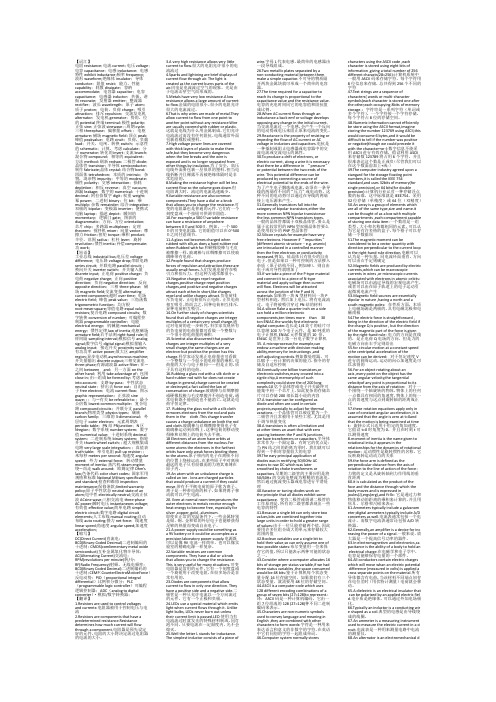
【词汇】电阻resistance;电流current;电压voltage;电容capacitance;电感inductance;电感特性exhibit inductance;频率frequency;波形waveform;绝缘体insulator;导体conductor;阻值resist;能力,性能capability;耗散dissipate;容纳accommodate;电容器capacitor;电容capacitance;电感器inductor;共振,谐振resonate;发射器emitter;整流器rectifier;波长wavelength;原子atom;质子proton;电荷,负荷charge;吸引attraction;排斥repulsion;交流发电机alternator;发电机generator;势的,位的potential终端terminal;极性polarity;正弦sine;正弦波sinewave;;周期cycle;三相threephase;偏移量offset;;电枢armature;磁场magnetic field;顶点peak;峰值peakvalue;电路ciruit;负荷,负载load;开关,电闸,转换switch;示意性的schematic;计算,考虑calculate;分子numerator;转化的invert;支流branch;混合物compound;相等的equivalent;方法method;刷新redraw;二极管diode;晶体管transistor;半导体semiconductor;制作fabricate;晶体crystal;结合物bond;四面体tetrahedron;本质的intrinsic;杂物,混杂物impurity;中等的moderate;极性polarity;交感interaction;损耗depletion;相反reverse;真空vacuum;泄漏leakage;数字的numerical;十进制decimal;阿拉伯数字digit;权重weight;幂power;二进制binary;位bit;乘multiply;余数remainder;综合integration;双极的bipolar;变极器inverter;便携式电脑laptop;描述depict;瞬间的momentary;逻辑门gate;图表的diagrammatic;方向,方位orientation;芯片chip;多路器multiplexer;定理theorem;搅拌机mixer;向量vector;摩擦力friction;扭矩torque;乘积product;半径,范围radius;杠杆lever;旋转revolution;惯性inertia;补偿compensate;功work;【短语】工业总线industrial bus;电压差voltage difference; 电压降voltage drop;串联电路series circuit; 并联电路parallel circuit; ;换向开关inverter switch;开关输入量discrete input; 正电荷positive charge;负电荷negative charge; 正向positive direction;负向negative direction;反向opposite direction;三相three-phase;磁场magnetic field;交流变量alternating current component;超时over time; 电场electric field; 峰值peak value;三角函数trigonometric function;均方根root-mean-square;等值电路equal value resistors;复合电路compound circuits; 数字转换conversion of number; 可编程控制器programmable controller;电能electrical energy;机械能mechanical energy;惯性定律law of inertia;电枢磁场armature field;右手法则right-hand rule;采样间隔sampling interval;模拟信号analog signal;数字信号digital signal;模拟量输入analog input;接近开关proximity switch;有功功率active power;放大区amplifier region;异步电动机asynchronous machine;开关量输出discrete output;三相交流电three-phase;有源滤波器active filter;在—之间between and;另一方面on the other hand;利用take advantage of;包围close in;由---组成be formed by;考虑take into account;支路by-pass;中性状态neutral state;挤出去force out;自由电子free electron;电流current flow;图示graphic representation;正弦波sine wave;;;与—有关be referable to;;最小公倍数lowest common multiple;复合电路compound circuits;并联分支parallel branch;物理类型physics types;碳族carbon family;三维的3-dimensional;外层电子outer electron;元素周期表periodic table;PN结PNjunction;N区Nregion;数字系统number system;数字值numerical value;十进制系统decimal system;二进制系统binary system;指轮开关thumb wheel switch;;超大规模集成电路very large scale integration;;真值表truth table;牵引电阻pull-up resistor;;米每秒meters per second;角速度angular speed;外力external force;转动惯量moment of inertia;蒸汽机steam engine;绕—而走walk around;欧姆定律Ohm’s law;色条代码color chart codes;国家军用规格和标准National Military specification and standard;检查和维修inspection maintenance;保修条款;limited warranty policy;原子中性状态neutral state of an atom;电中性electrically neutral;交流正弦波ACsine wave;三相交流电three-phase AC power;瞬时电压instantaneons voltage;有效值effective value;简单电路simple electric circuit;数字电路digital circuit elememts;人工布线manual routing;自动布线auto routing;静力net force;线速度linear speed;角速度angular speed;加速度acceleration;【缩写】DC(Direct Current)直流电;BCD(Binary-Coded Decimal)二进制编码的十进制;CMOS(comliementary metal oxide semiconduct)互补金属氧化物半导体;AC(Alternating Current)交流电;RPM(revolutions per minute)转/分;RF(Radio Frequency)射频,无线电频率;BCD(Binary Coded Decimal)二进制编码的十进制;CEMF(CounterElectroMotiveForce)反电动势;PID(proportional integral differential)比例积分微分;PLC (programmable logic controller)可编程逻辑控制器;ADC(analog to digital converter)·模拟/数字转换器;【翻译】1.Resistors are used to control voltagesand currents:电阻器被用于控制电压与电流2.Resistors are components that have a predetermined resistance.Resistance determines how much current will flow through a component.电阻器是预先设定好的元件。
电气工程及其自动化专业英语介绍
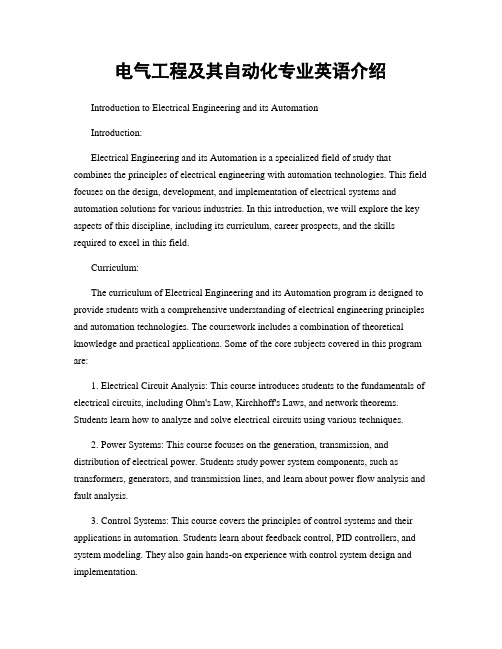
电气工程及其自动化专业英语介绍Introduction to Electrical Engineering and its AutomationIntroduction:Electrical Engineering and its Automation is a specialized field of study that combines the principles of electrical engineering with automation technologies. This field focuses on the design, development, and implementation of electrical systems and automation solutions for various industries. In this introduction, we will explore the key aspects of this discipline, including its curriculum, career prospects, and the skills required to excel in this field.Curriculum:The curriculum of Electrical Engineering and its Automation program is designed to provide students with a comprehensive understanding of electrical engineering principles and automation technologies. The coursework includes a combination of theoretical knowledge and practical applications. Some of the core subjects covered in this program are:1. Electrical Circuit Analysis: This course introduces students to the fundamentals of electrical circuits, including Ohm's Law, Kirchhoff's Laws, and network theorems. Students learn how to analyze and solve electrical circuits using various techniques.2. Power Systems: This course focuses on the generation, transmission, and distribution of electrical power. Students study power system components, such as transformers, generators, and transmission lines, and learn about power flow analysis and fault analysis.3. Control Systems: This course covers the principles of control systems and their applications in automation. Students learn about feedback control, PID controllers, and system modeling. They also gain hands-on experience with control system design and implementation.4. Digital Electronics: This course introduces students to digital logic circuits and their applications. Students learn about Boolean algebra, logic gates, flip-flops, and sequential circuits. They also gain practical knowledge of digital circuit design using software tools.5. Industrial Automation: This course focuses on the automation of industrial processes. Students learn about programmable logic controllers (PLCs), human-machine interfaces (HMIs), and industrial communication protocols. They also gain practical experience in designing and programming automation systems.6. Electromagnetic Fields and Waves: This course covers the principles of electromagnetic fields and their applications. Students study Maxwell's equations, electromagnetic wave propagation, and antenna theory. They also gain knowledge of electromagnetic compatibility and electromagnetic interference.Career Prospects:Graduates of the Electrical Engineering and its Automation program have a wide range of career opportunities in various industries. Some of the potential career paths include:1. Electrical Engineer: Graduates can work as electrical engineers, designing and implementing electrical systems for buildings, power plants, or transportation systems. They may be involved in projects related to power distribution, lighting systems, or renewable energy sources.2. Control Systems Engineer: Graduates can pursue a career in control systems engineering, where they design and optimize control systems for industrial processes. They may work on projects related to robotics, manufacturing automation, or process control.3. Automation Engineer: Graduates can work as automation engineers, developing and implementing automation solutions for industries such as manufacturing, oil and gas, or pharmaceuticals. They may be involved in projects related to PLC programming, HMI design, or industrial networking.4. Research and Development: Graduates can also choose to pursue a career in research and development, working on cutting-edge technologies in the field of electrical engineering and automation. They may be involved in developing new control algorithms, improving energy efficiency, or exploring advanced automation techniques.Skills Required:To excel in the field of Electrical Engineering and its Automation, students need to develop a range of technical and soft skills. Some of the key skills required are:1. Strong Analytical Skills: Electrical engineers need to analyze complex electrical systems and troubleshoot any issues that may arise. Strong analytical skills are essential for identifying problems and finding efficient solutions.2. Technical Knowledge: A solid understanding of electrical engineering principles, automation technologies, and programming languages is crucial for success in this field. Students should continuously update their knowledge to keep up with the latest advancements.3. Problem-Solving Abilities: Electrical engineers often encounter challenges while designing or implementing electrical systems. The ability to think critically and come up with innovative solutions is vital for overcoming these challenges.4. Communication Skills: Effective communication is essential for collaborating with colleagues, presenting ideas, and explaining complex concepts to clients or stakeholders. Strong written and verbal communication skills are highly valued in the industry.5. Teamwork: Many projects in electrical engineering and automation require collaboration with multidisciplinary teams. The ability to work well in a team, share ideas, and contribute to the overall project goals is crucial for success.Conclusion:Electrical Engineering and its Automation is a dynamic and rapidly evolving field that offers exciting career opportunities. The curriculum of this program equips students with the necessary knowledge and skills to design, implement, and optimize electricalsystems and automation solutions. Graduates of this program can pursue careers as electrical engineers, control systems engineers, automation engineers, or research and development professionals. With the right blend of technical expertise, problem-solving abilities, and effective communication skills, students can thrive in this field and contribute to the advancement of technology and automation.。
电气工程及其自动化专业英语介绍
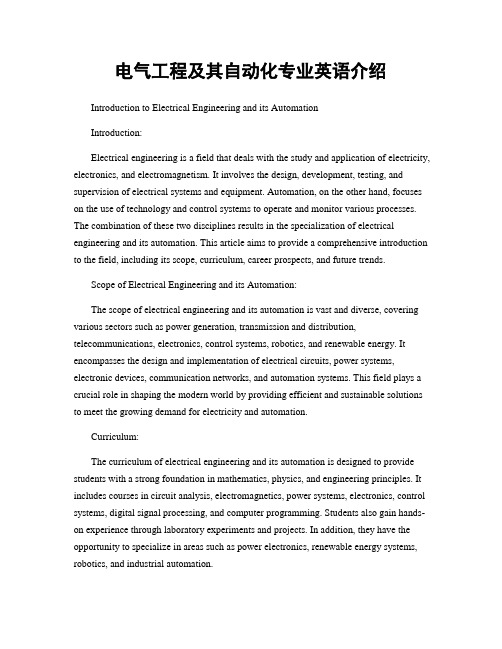
电气工程及其自动化专业英语介绍Introduction to Electrical Engineering and its AutomationIntroduction:Electrical engineering is a field that deals with the study and application of electricity, electronics, and electromagnetism. It involves the design, development, testing, and supervision of electrical systems and equipment. Automation, on the other hand, focuses on the use of technology and control systems to operate and monitor various processes. The combination of these two disciplines results in the specialization of electrical engineering and its automation. This article aims to provide a comprehensive introduction to the field, including its scope, curriculum, career prospects, and future trends.Scope of Electrical Engineering and its Automation:The scope of electrical engineering and its automation is vast and diverse, covering various sectors such as power generation, transmission and distribution, telecommunications, electronics, control systems, robotics, and renewable energy. It encompasses the design and implementation of electrical circuits, power systems, electronic devices, communication networks, and automation systems. This field plays a crucial role in shaping the modern world by providing efficient and sustainable solutions to meet the growing demand for electricity and automation.Curriculum:The curriculum of electrical engineering and its automation is designed to provide students with a strong foundation in mathematics, physics, and engineering principles. It includes courses in circuit analysis, electromagnetics, power systems, electronics, control systems, digital signal processing, and computer programming. Students also gain hands-on experience through laboratory experiments and projects. In addition, they have the opportunity to specialize in areas such as power electronics, renewable energy systems, robotics, and industrial automation.Career Prospects:Graduates of electrical engineering and its automation have excellent career prospects in various industries. They can work in power companies, manufacturing firms, telecommunications companies, research institutions, and government agencies. Job roles include electrical engineer, automation engineer, control systems engineer, power systems engineer, electronics engineer, and project manager. With the increasing focus on renewable energy and smart technologies, there is a growing demand for professionals in this field. Moreover, electrical engineers with expertise in automation are highly sought after in industries aiming for increased efficiency and productivity.Future Trends:The field of electrical engineering and its automation is constantly evolving, driven by technological advancements and societal needs. Some of the future trends in this field include:1. Renewable Energy: With the increasing concern for environmental sustainability, there is a shift towards renewable energy sources such as solar, wind, and hydroelectric power. Electrical engineers will play a crucial role in developing efficient and cost-effective renewable energy systems.2. Smart Grids: The integration of advanced communication and control technologies in power systems leads to the development of smart grids. These grids enable efficient energy management, real-time monitoring, and demand response. Electrical engineers will be at the forefront of designing and implementing smart grid solutions.3. Internet of Things (IoT): The IoT revolutionizes the way devices and systems communicate and interact with each other. Electrical engineers will be involved in designing IoT-enabled devices and developing communication protocols for seamless connectivity.4. Artificial Intelligence (AI) and Machine Learning: AI and machine learning techniques are being increasingly applied in automation systems. Electrical engineers willneed to have knowledge and skills in these areas to design intelligent automation solutions.Conclusion:In conclusion, electrical engineering and its automation is a dynamic and multidisciplinary field that offers a wide range of opportunities. The curriculum provides students with a strong foundation in theory and practical skills. Graduates can pursue rewarding careers in various industries and contribute to the development of sustainable and innovative solutions. With the ongoing technological advancements, the future of electrical engineering and its automation is promising, and professionals in this field will continue to play a vital role in shaping the world we live in.。
电气工程及其自动化专业英语

专业英语电路基础characterize描绘…的特征,塑造人物,具有….的特征property 性质,财产equal in magnitude to 在数量(数量级)上等同于convert 转换converter 转换器time rate 时间变化率mathematically 从数学上来讲differen tiate v 区分,区别in honor of 为纪念某人name in honor of为纪念某人而以他命名electromotive force (e m f )电动势voltaic battery 伏打电池,化学电池an element 一个电器元件interpret 口译,解释,说明the potential at point a with respect to point b is点a关于点b的电势Potential difference/voltage 电势差/电压expend 花费,消耗instantaneous 瞬时的,促发的passive sign convention 关联参考方向the law of conservation of energy 能量守恒定律reference polarity 参考极性electron 电子electronic 电子的electric 电的,电动的time-varying 时变的constant-valued 常量的metal lic 金属的be due to 是因为,由于,归功于building block 模块Coulomb库伦,Ampere安培,joule焦耳,Volt伏特,Watt瓦特,work 功变量u(t),i(t)是电路中最基本的概念。
他们描述了电路中的各种关系。
电荷量的概念是解释电现象的基本原理,电荷量也是电路中最基本的量。
电荷也是构成物质的原子的电器属性,量纲是库伦。
我们从初等物理可以得知所有物质是由基本组成部分原子组成,而原子又包括电子(electron),质子(proton)和中子(neutron)我们都知道电荷e是带负电的电子,在数量上等于1.60210*1019 C, 而质子携带同等电荷量的正电荷,相同数量的质子,电子使原子呈现电中性(neutrally charged)。
电气工程及其自动化专业英语
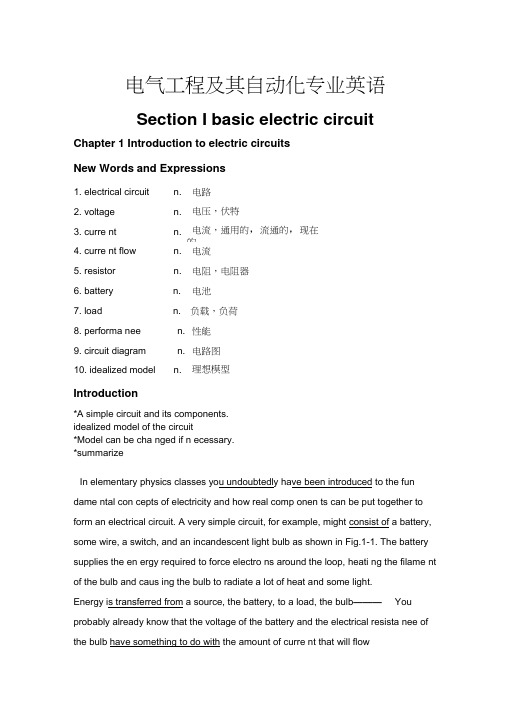
电气工程及其自动化专业英语Section I basic electric circuitChapter 1 Introduction to electric circuitsNew Words and Expressions1. electrical circuit n. 电路2. voltage n. 电压,伏特3. curre nt n. 电流,通用的,流通的,现在的4. curre nt flow n. 电流5. resistor n. 电阻,电阻器6. battery n. 电池7. load n. 负载,负荷8. performa nee n. 性能9. circuit diagram n. 电路图10. idealized model n. 理想模型Introduction*A simple circuit and its components.idealized model of the circuit*Model can be cha nged if n ecessary.*summarizeIn elementary physics classes you undoubtedly have been introduced to the fun dame ntal con cepts of electricity and how real comp onen ts can be put together to form an electrical circuit. A very simple circuit, for example, might consist of a battery, some wire, a switch, and an incandescent light bulb as shown in Fig.1-1. The battery supplies the en ergy required to force electro ns around the loop, heati ng the filame nt of the bulb and caus ing the bulb to radiate a lot of heat and some light.Energy is transferred from a source, the battery, to a load, the bulb———You probably already know that the voltage of the battery and the electrical resista nee of the bulb have something to do with the amount of curre nt that will flowin the circuit. From your own practical experienee you also know that no current will flow until the switch is closed. That is, for a circuit to do anything, the loop has to be completed so that electro ns can flow from the battery to the bulb and the n back aga in to the battery. And fin ally, you probably realize that it doesn t much matter, whether there is on e foot or two feet of wire connecting the battery to the bulb, but that it probably would matter if there is a mile of wire between it and the bulb.Also shown in Fig. 1-1 is a model made up of idealized components. The batteryis modeled as an ideal source that puts out a constant voltage, VB, no matter what amount of curre nt, i, is draw n. The wires are con sidered to be perfect con ductors that offer no resista nee to curre nt flow. The switch is assumed to be ope n or closed. There is no arcing of curre nt across the gap whe n the switch is ope ned, nor is there any bounce to the switch as it makes con tact on closure. The light bulb is modeled as a simple resistor, R, that never changes its value, no matter how hot it becomes or how much curre nt is flow ing through it.Fig. 1-1 (a) A simple circuit(b) An idealized represe ntati on of thecircuitFor most purposes, the idealized model shown in Fig. 1-1b is an adequate represe ntati on of the circuit; that is, our prediction of the current that will flow through the bulb whenever the switch is closed will be sufficiently accurate that we can consider the problem solved. There may be times, however, when the model is in adequate. The battery voltage, for example, may drop as more and more curre nt is drawn, or as the battery ages. --------------------------------- T he light bulb' s resistance may change as it heats up, and the filame nt may have a bit of inductance and capacitance associated with it as well as resistance so that when the switch is closed, the current may not jump in sta ntan eously from zero to some fin al, steady state value. The wires may beundersized, and some of the power delivered by the battery may be lost in the wires before it reaches the load. These subtle effects may or may not be important, depending on what we are trying to find out and how accurately we must be able to predict the performa nee of the circuit. If we decide they are importa nt, we can always cha nge the model as n ecessary and then proceed with the an alysis. The point here is simple. The comb in ati ons of resistors, capacitors, in ductors, voltage sources, curre nt sources, and so forth, that you see in a circuit diagram are merely models of real comp onents that comprise a real circuit, and a certa in amount of judgme nt is required to decide how complicated the model must be before sufficie ntly accurate results can be obta in ed. For our purposes, we will be using very simple models in general, leav ing many of the complicati ons to more adva need textbooks.Chapter 2Definitions of key electrical quantitiesNew Words and Expressionscharge n. vt.电荷;充电nu cleus n.原子核(pl.); nuclear adj.n egative n.否定,负数,底片adj.否定的,消极的,负的,阴性的positive adj.[数]正的adj.[电]阳的in gen eral 通常,大体上,一般而言,总的说来algebraic adj.代数的,关于代数学的soluti on to the circuit problem n.关于电路问题的解法the un its of power n.功率的单位direct curre nt (dc) n 直流电alter nat ing curre nt(ac) n.交流电sinu soidally adv.正弦地tran sistor n.晶体管Part 1 Charge and CurrentAn atom con sists of a positively charged nu cleus surro un ded by a swarm of n egativelycharged electr ons. The charge associated with one electr on has bee n found to be 1.602 x 10- 19 coulombs; or, stated the other way around, one coulomb can be defined as the charge on 6.242 x 1018 electro ns. While most of the electr ons associated with an atom are tightly bound to the nu cleus, good con ductors, like copper, have free electrons that are sufficie ntly dista nt from their nu clei that their attract ion to any particular n ucleus is easily overcome. These con ducti on electr ons are free to wan der from atom to atom, and their moveme nt con stitutes an electric curre nt.In a wire, when one coulomb ' s worth of charge passes a given spot in one second, the current is defined to be one ampere (abbreviated A), named after the nineteenth-century physicist Andr ' e Marie Amp'ere. That is, curre nt i is the net rate of flow of charge q past a point, or through an area:i=d q/d t (1.1)In general, charges can be negative or positive. For example, in a neon light, positive ions move in one direct ion and n egative electr ons move in the other. Each con tributes to curre nt, and the total curre nt is their sum. By conven ti on, the direct ion of curre nt flow is take n to be the direct ion that positive charges would move, whether or not positive charges happen to be in the picture. Thus, in a wire, electrons moving to the right constitute a current that flows to the left, as shown in Fig.1-2.(〉)dq--- / =—dtFig. 1-2 By conven tio n, n egative charges movi ng in one direct ion con stitute a positive curre ntflow in the opposite direct ionW/hen charge flows at a steady rate in one direction only, the current is said to be direct current, or 血A battery, for example, supplies direct curre nt. When charge flows back and forth sinusoidally, it is said to be alternating current, or ac. In the United States the ac electricity delivered by tes of ac and dc are show n in Fig.1-3.Time ―(a)Fig. 1-3 (a) Steady-state direct curre nt (de) (b) Alter nat ing curre nt(ac)Part 2 Kirchhoff' s Current LawTwo of the most fun dame ntal properties of circuits were established experime ntally a cen tury and a half ago by a Germa n professor, Gustav Robert Kirchhoff (1824 - 1887). The first property, known as Kirchhoff ' s current law (abbreviated KCL), states that at every instant of time the sum of the curre nts flow ing into any node of a circuit must equal the sum of the curre nts leavi ng the no de, where a node is any spot where two or more wires are join ed. This is a very simple, but powerful con cept. It is in tuitively obvious once you assert that curre nt is the flow of charge, and that charge is con servative—n either being created nor destroyed as it en ters a no de. Uni ess charge somehow builds up at a no de, which it does not, the n the rate at which charge en ters a node must equal the rate at which charge leaves the no de.There are several alter native ways to state Kirchhoff ' s curre nt law. The most com monly used stateme nt says that the sum of the curre nts flow ing into a node is zero as show n in Fig. 1-4a, in which case some of those curre nts must have n egative values while some have positive values. Equally valid would be the stateme nt that the sum of the curre nts leav ing a node must be zero as show n in Fig. 1-4b(aga in some of these curre nts n eed to have positive values and some n egative). Fin ally, we could say that the sum of the curre nts en teri ng a node equals the sum of the curre nts leav ing a node (Fig. 1-4c). These are all equivale nt as long as we un dersta nd what is meant about the directi on of curre nt flow whe n we in dicate it with an arrow on a circuit diagram. Curre nt that actually flows in the directi on show n by the arrow is give n a positive sig n. Curre nts that actuallyflow in the opposite direct ion have n egative values.(a) The sum of the curre nts into a node equals zero(b) The sum of the curre nts leav ing the node is zero(c) The sum of the curre nts en teri ng a node equals the sum of the curre nts leavi ng the node Note that you can draw curre nt arrows in any directio n that you want — that much is arbitrary — but once havi ng draw n the arrows, you must the n write Kirchhoff ' s curre nt law in a manner that is con siste nt with your arrows, as has bee n done in Fig.1-4. The algebraic soluti on to the circuit problem will automatically determ ine whether or not your arbitrarily determ ined direct ions for curre nts were correct.Example 1.1 Using Kirchhoff ' s Current LawA node of a circuit is shown with current direction arrows chosen arbitrarily. Havingpicked those directi on s, i1 = - 5 A, i2 = 3 A, and i3 = - 1 A. Write an expressi on for Kirchhoff ' s current law and solve for i4.Solution. By Kirchhoff ' s current law,i1 + i2 = i3 + i4 so thatThat is, i4is actually 1 A flowi ng into the no de. Note that i2, i3, and i4 are all en teri ng the no de, and i1 is the only curre nt that is leavi ng the no de.Part 3 Kirchhoff ' s Voltage LawElectr ons won ' t flow through a circuit uni ess they are give n some en ergy to help send them on their way. That “ push ” is measured in volts, where voltage is defi ned to be the amount nodenodenode1 + i4 i4 = - 1 AFig. 1-4 lllustrating various ways that Kirchhoff ' s current law can be statedof en ergy (w, joules) give n to a un it of charge,v=dw/dq A 12-V battery therefore gives 12 joules of en ergy to each coulomb of charge that it stores. Note that the charge does not actually have to move for voltage to have meaning. Voltage describes the potential for charge to do work.While curre nts are measured through a circuit comp onent, voltages are measured across componen ts. Thus, for example, it is correct to say that curre nt through a battery is 10 A, while the voltage across that battery is 12 V. Other ways to describe the voltage across a comp onent in clude whether the voltage rises across the comp onent or drops. Thus, for example, for the simple circuit in Fig. 1-1, there is a voltage rise across the battery and voltage drop across the light bulb. Voltages are always measured with respect to someth ing. That is, the voltage of the positive terminal of the battery is“ so many volts ” with respect to the negative terminal; or, the voltage at a point in a circuit is some amount with respect to some other poin t. In Fig. 1-5, curre nt through a resistor results in a voltage drop from point A to point B of VAB volts. V A and VB arethe voltages at each end of the resistor, measured with respect to some other point.The reference point for voltages in a circuit is usually desig nated with a ground symbol. While many circuits are actually groun ded — that is, there is a path for curre nt to flow directly into the earth —some are not (such as the battery, wires, switch, and bulb in a flashlight). When a ground symbol is show n on a circuit diagram, you should con sider it to be merely a reference point at which thevoltage is defi ned to be zero. Fig.1-6 points out how cha nging the node labeled as ground cha nges the voltages at each node in the circuit, but does not cha nge the voltage drop across each comp onent.(1-2)Fig. 1-5 The voltage drop from point A to point B is V AB, where VAB = VA - VBThe sec ond of Kirchhoff ' s fun dame ntal laws states that the sum of the voltages around any loop of a circuit at any instant is zero. This is known as Kirchhoff ' s voltage law (KVL). Just as was the case for Kirchhoff ' s curre nt law, there are alter native, but equivale nt, ways of stat ing KVL. We can, for example, say that the sum of the voltage rises in any loop equals the sum of the voltagedrops around the loop. Thus in Fig. 1-6, there is a voltage rise of 12 V across the battery and avoltage drop of 3 V across R1 and a drop of 9 V across R2. ------------- Notice that it doesn' t matterwhich node was labeled ground for this to be true. Just as was the case with Kirchhoff ' s current law, we must be careful about labeli ng and in terpret ing the sig ns of voltages in a circuit diagram in order to write the proper vers ion of KVL. A plus (+) sig n on a circuit comp onent in dicates a reference direct ion un der the assumpti on that the pote ntial at that end of the comp onent is higher than the voltage at the other end. Aga in, as long as we are con siste nt in writi ng Kirchhoff ' s voltage law, the algebraic soluti on for the circuit will automatically take care of sig ns.Part 5 Summary of Principal Electrical QuantitiesThe key electrical qua ntities already in troduced and the releva nt relati on ships betwee n these quantities are summarized in Table 1-1.Since electrical quantities vary over such a large range of magnitudes, you will often find yourself work ing with very small qua ntities or very large qua ntities. For example, the voltage created by your TV antenna may be measured in millionths of a volt (microvolts, 卩V), while the power gen erated by a large power stati on may be measured in billi ons of watts, or gigawatts (GW). To describe quantities that may take on such extreme values, it is useful to have a system of prefixes that accompany the units. The most commonly used prefixes in electrical engineering are give n in Table 1-2.Part 6 Ideal Voltage Source and Ideal Current SourceElectric circuits are made up of a relatively small nu mber of differe nt kinds of circuiteleme nts, or comp onen ts, which can be in terc onn ected in an extraord in arily large nu mber of ways.At this point in our discussion, we will concentrate on idealized characteristics of these circuit eleme nts, realiz ing that real comp onents resemble, but do not exactly duplicate, the characteristics that we describe here.An ideal voltage source is one that provides a give n, known voltage vs, no matter what sort ofload it is conn ected to. That is, regardless of the curre nt draw n from the ideal voltage source, it will always provide the same voltage. Note that an ideal voltage source does not have to deliver a con sta nt voltage; for example, it may produce a sinu soidally vary ing voltage —the key is that voltage is not a fun ctio n of the amount of curre nt draw n. A symbol for an ideal voltage source is show n in Fig. 1-7.A special case of an ideal voltage source is an ideal battery that provides a con sta nt dc output, as show n in Fig. 1-8. A real battery approximates the ideal source; but as curre nt in creases, the output drops somewhat. To acco unt for that drop, quite ofte n the model used for a real battery is an ideal voltage source in series with the internal resista nee of the battery.An ideal curre nt source produces a give n amount of curre nt is no matter what load it sees. As show n in Fig. 1-9, a commo nly used symbol for such a device is circle with an arrow in dicati ng the directi on of curre nt flow. While a battery is a good approximati on to an ideal voltage source, there is nothing quite so familiar that approximates an ideal curre nt source. Some tran sistor circuits come close to this ideal and are ofte n modeled with idealized curre nt sources.Section II The electric power systemChapter 1 Brief Introduction to The Electric Power SystemNew Words and ExpressionsMinimum a 最小prime mover n 原动机gen erator n 发电机load n 负载furn ace n 炉膛boiler n 锅炉fissi on able n 可裂变的fissi on able material 核燃料Part 1 Minimum Power systemelevatio n n 高度,海拔internal combusti on engine 内燃机 steam-drive n turbi ne 汽轮机hydraulic turbi ne 水轮机convert v 变换,转换 shaft n 传动轴,轴 torquen 力矩servomecha nism n 伺服机构* Elements of a minimum electric power system *Types of energy source *Types of prime mover *Types of electrical load*Functions of the control systemA minimum electric power system is shown in Fig.1-1, the system consists of an energy source, a prime mover, a generator, and a load.The en ergy source may be coal, gas, or oil burned in a furnace to heat water and gen erate steam in a boiler; it may be fissi on able material which, in a nu clear reactor, will heat water to produce steam; it may be water in a pond at an elevatio n above the gen erat ing stati on; or it may be oil or gas burned in an internal combusti on engine.The prime mover may be a steam-driven turbine, a hydraulic turbine or water wheel, or aninternal combustion engine. Each one of these prime movers has the ability to convert energy in the form of heat, falling water, or fuel into rotation of a shaft, which in turn will drive theEnergy source Prime nioverGenerator Lx>adContjolFig* 1-1 The tninfnmm electric power systemgen erator.The electrical load on the gen erator may be lights, motors, heaters, or other devices, alone or in comb in ati on. Probably the load will vary from mi nute to min ute as differe nt dema nds occur. The control system functions (are ) to keep the speed of the machines substantially constant and the voltage within prescribed limits, even though the load may cha nge. To meet these load con diti on s, it is n ecessary for fuel in put to cha nge, for the prime mover in put to vary, and for the torque on the shaft from the prime mover to cha nge in order that the gen erator may be kept at con sta nt speed. In additi on, the field curre nt to the gen erator must be adjusted to maintain con sta nt output voltage. The con trol system may in clude a man stati oned in the power pla nt who watches a set of meters on the gen erator output term in als and makes the n ecessary adjustme nts manu ally .In a moder n stati on, the con trol system is a servomecha nism that sen ses gen erator-output con diti ons and automatically makes the n ecessary cha nges in en ergy in put and field curre nt to hold the electrical output with in certa in specificati ons.Part 2 More Complicated Systems*Foreword*Cases of power system with out circuit breaker *Power system with circuit breakerNew Words and Expressions1. associated2. circuit3. circuit breaker4. dee nergize5. dee nergized6. outage n7. diagram8. switch out of9. switch offIn most situati ons the load is not directly conn ected to the gen erator term in als. More com monlya 联接的 n 电路n 断路器 vt 切断,断电 adj 不带电的停电 n 简图退出来,断开 v 切断,关闭the load is some distanee from the generator, requiring a power line connecting them. It is desirable to keep the electric power supply at the load with in specificati ons. However, the con trols are near the generator, which may be in another building, perhaps several miles away.If the dista nce from the gen erator to the load is con siderable, it may be desirable to in stall transformers at the generator and at the load end, and to transmit the power over a high-voltage line (Fig.1-2). For the same power, the higher-voltage line carries less current, has lower losses for the same wire size, and provides more stable voltage., TransformerTransformerPrime 〔Mover Generator f C High-voltage line—Fig- 1-2 A generator connected through transformers anda high-voltage line to a distant loadIn some cases an overhead line may be un acceptable. In stead it may be adva ntageous to use an un dergro und cable. With the power systems talked above, the power supply to the load must be in terrupted if, for any reas on, any comp onent of the system must be moved from service for maintenance or repair.Additi onal system load may require more power tha n the gen erator can supply. Ano ther gen erator with its associated tran sformers and high-voltage line might be added.It can be shown that there are some advantages in making ties between the generators (1) and at the end of the high-voltage lines (2 and 3), as shown in Fig.1-3. This system will operate satisfactorily as long as no trouble develops or no equipment needs to be taken out of service.Kig. 1-3 A system with para)lei operation or the generators t of the transformers andof the transmission lintsThe above system may be vastly improved by the in troducti on of circuit breakers, which may be ope ned and closed as n eeded. Circuit breakers added to the system, Fig.1-4, permit selected piece of equipme nt to switch out of service without disturb ing the rema in der of system. With this arran geme nt any eleme nt of the system may be dee nergized for maintenance or repair by operati on of circuit breakers. Of course, if any piece of equipme nt is take n out of service, the n the total load must be carried by the remaining equipment. Attention must be given to avoid overloads duri ng such circumsta nces. If possible, outages of equipme nt are scheduled at times when load requireme nts are below no rmal.Low-voltageo=^GeneratorsFig.1-5 shows a system in which three gen erators and three loads are tied together by threeFig* 1-4 A system with necessary circuit breakerstran smissi on lin es. No circuit breakers are show n in this diagram, although many would berequired in such a system.Fis- 1-S Three generators supplying threeloads over hlgh-voltnge trAnsmlsston linesChapter 2 Faults on Power SystemNew Words and Expressions1. fault2. in terfere neen 干扰,防碍6. feed (fed)给。
电气工程及其自动化专业英语苏小林
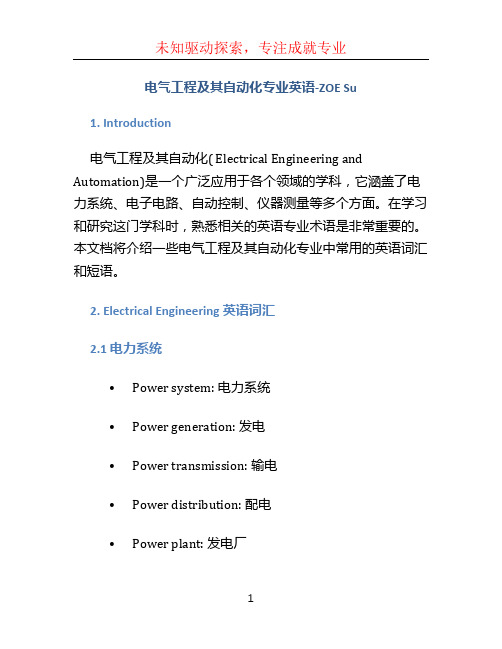
电气工程及其自动化专业英语-ZOE Su1. Introduction电气工程及其自动化( Electrical Engineering and Automation)是一个广泛应用于各个领域的学科,它涵盖了电力系统、电子电路、自动控制、仪器测量等多个方面。
在学习和研究这门学科时,熟悉相关的英语专业术语是非常重要的。
本文档将介绍一些电气工程及其自动化专业中常用的英语词汇和短语。
2. Electrical Engineering 英语词汇2.1 电力系统•Power system: 电力系统•Power generation: 发电•Power transmission: 输电•Power distribution: 配电•Power plant: 发电厂•Substation: 变电站•Transformer: 变压器•Generator: 发电机•Transmission line: 输电线路•Circuit breaker: 断路器•Load: 负载2.2 电子电路•Circuit: 电路•Resistor: 电阻器•Capacitor: 电容器•Inductor: 电感器•Diode: 二极管•Transistor: 晶体管•Integrated circuit (IC): 集成电路•Printed circuit board (PCB): 印制电路板•Voltage: 电压•Current: 电流2.3 自动控制•Control system: 控制系统•Feedback: 反馈•PID controller: 比例积分微分(PID)控制器•Sensor: 传感器•Actuator: 执行器•Control signal: 控制信号•Closed-loop control: 闭环控制•Open-loop control: 开环控制2.4 仪器测量•Instrumentation: 仪器测量•Measurement: 测量•Accuracy: 精度•Calibration: 校准•Sensor: 传感器•Meter: 仪表•Voltmeter: 电压计•Ammeter: 电流计•Oscilloscope: 示波器•Multimeter: 电表3. Electrical Engineering 英语短语3.1 电力系统•Power blackout: 停电•Grid integration: 网络集成•Load shedding: 负荷调节•Power factor: 功率因数•Power outage: 断电•Voltage regulation: 电压调节•Renewable energy: 可再生能源•Power factor correction: 功率因数校正•Power supply: 电源3.2 电子电路•Logic gate: 逻辑门•Circuit design: 电路设计•Printed circuit board (PCB) design: 印刷电路板设计•Analog circuit: 模拟电路•Digital circuit: 数字电路•Circuit analysis: 电路分析•Circuit simulation: 电路仿真•Circuit board layout: 电路板布局•Electronic component: 电子元件•Circuit diagram: 电路图3.3 自动控制•Automatic control: 自动控制•Control loop: 控制回路•Feedback loop: 反馈回路•Control system design: 控制系统设计•Proportional control: 比例控制•Integral control: 积分控制•Derivative control: 微分控制•Control algorithm: 控制算法•System response: 系统响应•Setpoint: 设定值3.4 仪器测量•Measurement uncertainty: 测量不确定性•Precision measurement: 精密测量•Measurement accuracy: 测量准确性•Metrology: 计量学•Calibration procedure: 校准程序•Test equipment: 测试设备•Instrument calibration: 仪器校准•Measurement range: 测量范围•Measurement error: 测量误差•Data acquisition: 数据采集4. 总结掌握电气工程及其自动化专业中的英语词汇和短语是很有必要的,它可以帮助我们更好地理解和交流相关知识。
电气工程及其自动化专业英语第二章第四节

Energy conversion
01
Motors and power electronics are essential components of power systems, converting electrical energy into mechanical energy and vice verse
Coordinated operation
Multiple power plants and transmission lines are connected to form a large, interconnected grid that allows electricity to be transmitted over long distances
Definition of Electrical Enginetomation technology refers to the use of machines, systems, and processes that can perform tasks without human intervention It involves the integration of sensors, actors, controllers, and information technology to achieve effectiveness, accuracy, and repeatable operations
Transmission
High voltage transmission lines that carry electricity over long distances to ensure the reliable supply of power to the grid
电气工程及其自动化专业英语复习资料
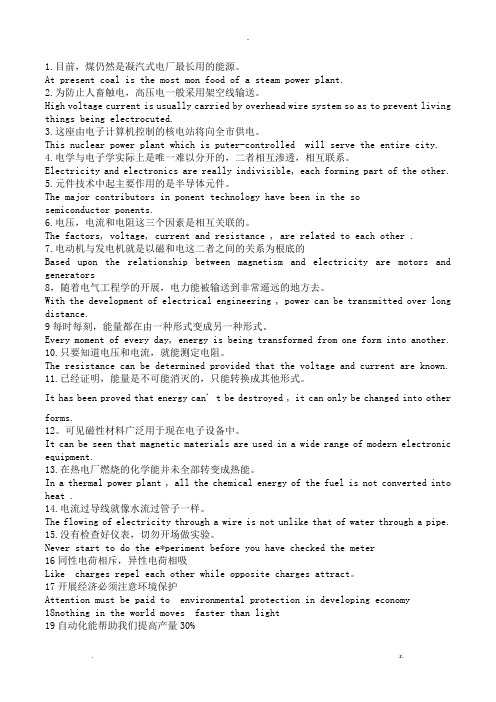
1.目前,煤仍然是凝汽式电厂最长用的能源。
At present coal is the most mon food of a steam power plant.2.为防止人畜触电,高压电一般采用架空线输送。
High voltage current is usually carried by overhead wire system so as to prevent living things being electrocuted.3.这座由电子计算机控制的核电站将向全市供电。
This nuclear power plant which is puter-controlled will serve the entire city. 4.电学与电子学实际上是唯一难以分开的,二者相互渗透,相互联系。
Electricity and electronics are really indivisible, each forming part of the other.5.元件技术中起主要作用的是半导体元件。
The major contributors in ponent technology have been in the sosemiconductor ponents.6.电压,电流和电阻这三个因素是相互关联的。
The factors, voltage, current and resistance , are related to each other .7.电动机与发电机就是以磁和电这二者之间的关系为根底的Based upon the relationship between magnetism and electricity are motors and generators8,随着电气工程学的开展,电力能被输送到非常遥远的地方去。
With the development of electrical engineering , power can be transmitted over long distance.9每时每刻,能量都在由一种形式变成另一种形式。
电气工程及其自动化专业英语介绍
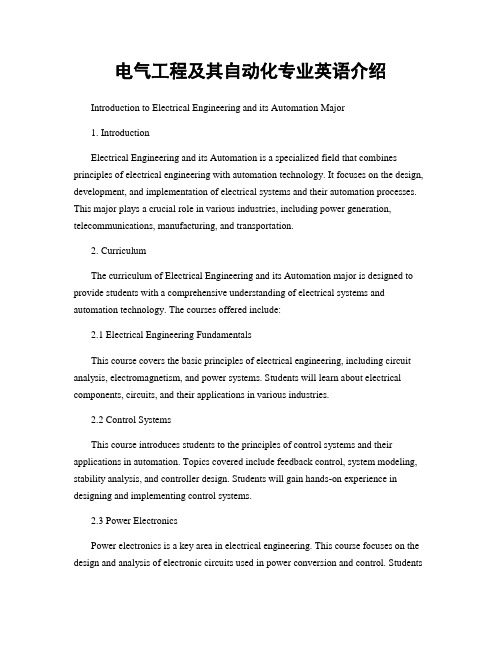
电气工程及其自动化专业英语介绍Introduction to Electrical Engineering and its Automation Major1. IntroductionElectrical Engineering and its Automation is a specialized field that combines principles of electrical engineering with automation technology. It focuses on the design, development, and implementation of electrical systems and their automation processes. This major plays a crucial role in various industries, including power generation, telecommunications, manufacturing, and transportation.2. CurriculumThe curriculum of Electrical Engineering and its Automation major is designed to provide students with a comprehensive understanding of electrical systems and automation technology. The courses offered include:2.1 Electrical Engineering FundamentalsThis course covers the basic principles of electrical engineering, including circuit analysis, electromagnetism, and power systems. Students will learn about electrical components, circuits, and their applications in various industries.2.2 Control SystemsThis course introduces students to the principles of control systems and their applications in automation. Topics covered include feedback control, system modeling, stability analysis, and controller design. Students will gain hands-on experience in designing and implementing control systems.2.3 Power ElectronicsPower electronics is a key area in electrical engineering. This course focuses on the design and analysis of electronic circuits used in power conversion and control. Studentswill learn about power semiconductor devices, converters, inverters, and their applications in power systems.2.4 Programmable Logic Controllers (PLCs)PLCs are widely used in automation systems for controlling and monitoring industrial processes. This course provides students with a deep understanding of PLC programming, ladder logic, and industrial automation. Students will learn how to design and implement automation systems using PLCs.2.5 Robotics and AutomationThis course explores the principles and applications of robotics and automation. Students will learn about robot kinematics, dynamics, control, and programming. They will also gain practical experience in designing and operating robotic systems.3. Career OpportunitiesGraduates of the Electrical Engineering and its Automation major have excellent career prospects in various industries. Some of the potential career paths include:3.1 Electrical EngineerElectrical engineers are responsible for designing, developing, and maintaining electrical systems. They work in industries such as power generation, telecommunications, and manufacturing. Their roles may involve designing electrical circuits, troubleshooting electrical issues, and ensuring compliance with safety standards.3.2 Automation EngineerAutomation engineers specialize in designing and implementing automation systems. They work with control systems, PLCs, and robotics to optimize industrial processes and improve efficiency. Their responsibilities may include system integration, programming, and troubleshooting.3.3 Power Systems EngineerPower systems engineers focus on the generation, transmission, and distribution of electrical power. They are involved in designing and maintaining power grids, ensuring reliable power supply, and implementing renewable energy solutions. Their work is crucial for meeting the increasing demand for clean and sustainable energy.3.4 Research and DevelopmentGraduates can also pursue careers in research and development, working on innovative technologies and solutions in the field of electrical engineering and automation. They may work in academic institutions, government research labs, or private companies, contributing to advancements in the industry.4. ConclusionThe Electrical Engineering and its Automation major offers a comprehensive education in electrical systems and automation technology. Graduates are equipped with the knowledge and skills to excel in various industries and contribute to technological advancements. With a high demand for professionals in this field, graduates can look forward to exciting career opportunities and a promising future in the ever-evolving field of electrical engineering and automation.。
电气工程及其自动化专业英语
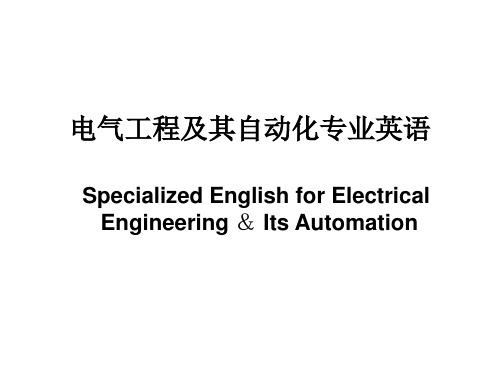
voltage drop 电压降 volt-ampere characteristics 伏安特性
metal-filament lamp 金属丝灯泡
carbon-filament lamp 碳丝灯泡
non-linear characteristics 非线性特性
Unit 1 Circuit Elements and Parameters
• With time-invariant currents and voltages, the magnetic anห้องสมุดไป่ตู้ electric fields of the associated electric plant are also timeinvariant. This is the reason why no e.m.f.s of self- (or mutual-)induction(自感或互感)appear in D.C. circuits, nor are there (倒装结构)any displacement currents (位移电 流)in the dielectric surrounding the conductors(导体周围的 电介质).
Techniques
Unit 1 Specialized English Words
circuit components 电路元件
circuit parameters 电路参数
the dielectric 电介质
storage battery 蓄电池
electric circuit 电路
wire导线
电气工程及其自动化专业英语
Specialized English for Electrical Engineering & Its Automation
电气工程及其自动化专业英语
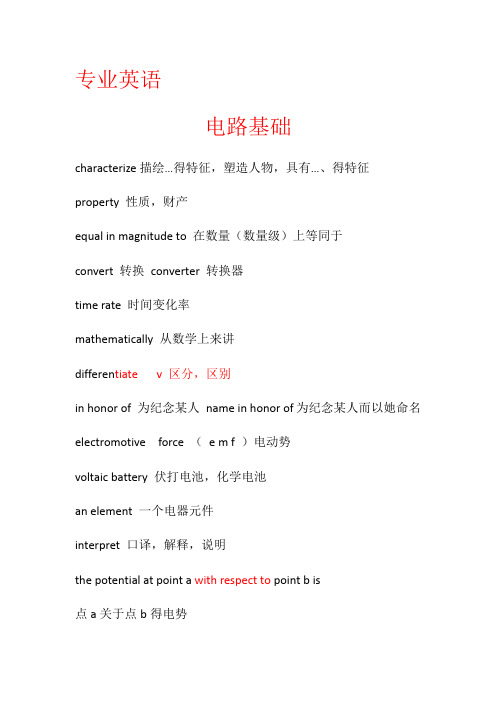
专业英语电路基础characterize描绘…得特征,塑造人物,具有…、得特征property 性质,财产equal in magnitude to 在数量(数量级)上等同于convert 转换converter 转换器time rate 时间变化率mathematically 从数学上来讲differen tiate v 区分,区别in honor of 为纪念某人name in honor of为纪念某人而以她命名electromotive force (e m f )电动势voltaic battery 伏打电池,化学电池an element 一个电器元件interpret 口译,解释,说明the potential at point a with respect to point b is点a关于点b得电势Potential difference/voltage 电势差/电压expend 花费,消耗instantaneous 瞬时得,促发得passive sign convention 关联参考方向the law of conservation of energy 能量守恒定律reference polarity 参考极性electron 电子electronic 电子得electric 电得,电动得time-varying 时变得constant-valued 常量得metal lic 金属得be due to 就是因为,由于,归功于building block 模块Coulomb库伦,Ampere安培,joule焦耳,Volt伏特,Watt瓦特,work 功变量u(t),i(t)就是电路中最基本得概念。
她们描述了电路中得各种关系。
电荷量得概念就是解释电现象得基本原理,电荷量也就是电路中最基本得量。
电荷也就是构成物质得原子得电器属性,量纲就是库伦。
我们从初等物理可以得知所有物质就是由基本组成部分原子组成,而原子又包括电子(electron),质子(proton)与中子(neutron)我们都知道电荷e就是带负电得电子,在数量上等于1、60210*1019 C, 而质子携带同等电荷量得正电荷,相同数量得质子,电子使原子呈现电中性(neutrally charged)。
- 1、下载文档前请自行甄别文档内容的完整性,平台不提供额外的编辑、内容补充、找答案等附加服务。
- 2、"仅部分预览"的文档,不可在线预览部分如存在完整性等问题,可反馈申请退款(可完整预览的文档不适用该条件!)。
- 3、如文档侵犯您的权益,请联系客服反馈,我们会尽快为您处理(人工客服工作时间:9:00-18:30)。
专业英语电路基础characterize描绘…的特征,塑造人物,具有….的特征property 性质,财产equal in magnitude to 在数量(数量级)上等同于convert 转换 converter 转换器time rate 时间变化率mathematically 从数学上来讲differen tiate v 区分,区别in honor of 为纪念某人 name in honor of为纪念某人而以他命名electromotive force ( e m f )电动势voltaic battery 伏打电池,化学电池an element 一个电器元件interpret 口译,解释,说明the potential at point a with respect to point b is点a关于点b的电势Potential difference/voltage 电势差/电压expend 花费,消耗instantaneous 瞬时的,促发的passive sign convention 关联参考方向the law of conservation of energy 能量守恒定律reference polarity 参考极性electron 电子 electronic 电子的 electric 电的,电动的time-varying 时变的 constant-valued 常量的metal lic 金属的be due to 是因为,由于,归功于building block 模块Coulomb库伦,Ampere安培,joule焦耳,V olt伏特,Watt瓦特,work 功变量u(t),i(t)是电路中最基本的概念。
他们描述了电路中的各种关系。
电荷量的概念是解释电现象的基本原理,电荷量也是电路中最基本的量。
电荷也是构成物质的原子的电器属性,量纲是库伦。
我们从初等物理可以得知所有物质是由基本组成部分原子组成,而原子又包括电子(electron),质子(proton)和中子(neutron)我们都知道电荷e是带负电的电子,在数量上等于1.60210*1019 C,而质子携带同等电荷量的正电荷,相同数量的质子,电子使原子呈现电中性(neutrally charged)。
我们细想一下电荷的流动,电荷或电流的一个特征就是它是可移动的,就是说从一个地方以能量转换的形式转移到另外一个地方。
当一根导线与电池相连,电荷被迫移动,正负电荷朝相反方向移动,这种移动形成电流,通常把正电荷移动的方向当成电流移动的方向,也就是负电荷移动的反方向。
这个规定是由美国科学家本杰明-富兰克林提出的。
尽管我们现在知道金属导体中的电流是由负电荷运动引起的,我们还是遵从“电流是正电荷的正向移动”这个普遍接受的规定。
所以,电流时电荷的时间变化率。
数学上来讲,电流,电量,时间的关系是i=d q/dt ,t0到t时间内转移的电荷量可以通过等式两端积分得到。
我们定义电流的方式表明电流是一个恒量函数,电荷随时间以各种形式的变化可用不同的数学函数来表现。
要让电子在导体中按特定方向移动需要做功或有能量转移。
这功被当成是(electromotiveforce)外部电动势,这个电动势也被称作电压降或者电势差,电路中a,b两点间的电压就是把单位电荷从a移到b所需要的能量,从数学的角度讲,U=d w/d q,,式中w表示功,单位是焦,q表示电荷,单位是库伦,u表示电压,单位是伏,是为纪念第一个制造出化学电池的意大利物理学家亚历山大-安东尼奥-伏特而以他命名。
所以,电压(电势)就是让单位电荷通过一个元件所需的能量,量纲是伏特。
图展示了连接于a,b两点间元件两端的电压,加号和减号用来表示参考方向或电压极性。
电压可以用两种方式解释:1.a点电势高于b点电势2.点a关于点b的电压。
它遵循的逻辑关系一般这样表示U a b=-U b a。
尽管电压,电流是电路中两个基本的变量,单靠它们是不够的。
出于实用目的,我们要知道功率和能量。
要把功率和能量和电压,电流联系起来,我们回想一下物理可知,功率是消耗或吸收能量的时率,量纲是瓦特。
我们把这种关系记作p=d w/dt,式中p是功率,单位是瓦,w是能量,单位是焦。
从上面几个式子可得p=u*i ,因为u和i通常是时间函数,而功率是时变的量,被称为瞬时功率。
这吸收或放出的功率是元件两端电压和通过它的电流的乘积。
如果功率有一个加号,那么被输送功率或元件吸收功率。
相反,如果功率有一个减号,则元件提供(释放)能量,但是我们怎么知道什么时候功率是正或负呢?电流方向和电压极性在决定功率符号起决定作用。
所以注意电压和电流之间的关系是非常重要的。
电压极性和电流方向必须如图示一致才能保证功率符号是正的,这就是我们熟知的关联参考方向(passive signconvention)从关联参考方向得知,电流从电压的正极流入,在这种情况下,p 大于0,表示元件吸收功率,但是如果p小于0,元件释放或提供能量。
实际上,所有电路都遵循(the law of conservation ofenergy )能量守恒定律,因此,电路中功率的代数和在任何时刻都等于0。
这再次验证了提供给电路的总功率和吸收的总功率相等这个事实。
电路元件Active/passive element 有源/无源元件Inductor 电感器Ideal independent source 理想独立源Dependent/controlled source 受控源Constant voltage source 恒定电压源Diamond-shaped 菱形的Transistor 晶体管Amplifier 放大器Integrated circuit 集成电路By the same token 同理,同样,另外,还有一个电路就是一些电气元件的连接。
电路中有两种类型的元件:无源元件和有源元件。
有源元件能够产生能量而无源元件则不能。
无源元件的例子有:电阻,电容,电感。
最重要的有源元件就是向电路中所有与之相连的元件提供电能的电压和电流源。
一个理想的独立源是一个能够提供独立于其他变量的特定电压或电流。
一个独立电压源是一个二端元件,就像电池或发电机那样两个段子间维持特定电压值,这个电压和通过元件的电流是独立的。
电压源的符号是两个端子间有一个U伏的电压,如图所示。
极性如图,表明a端电压比b端高U伏,所以,如果U大于0,a端电势比b端电势高(terminal a is at a higher potential than terminal b ),反之亦可解释。
当然,如果U小于0,电压U可能是时变的,也有可能是恒定的,所以我们尚且标记为电压U。
另一个经常用作恒定电压源的符号,就好像是电池两端有U伏电压,如图所示。
恒流源情况下可以用左图两种方式表示,而且可以互换。
由于极性可以通过电池符号长线短线的位置来确定,我们可以观察到这时图示的极性符号就是多余的。
一个独立电流源就能有特定值电流流过的二端元件,这个电流与元件两端的电压是独立的。
独立电流源的符号如图所示,其中是一个定值,电流方向通过箭头方向表明。
独立源注定是向外部电路输出功率而不是吸收功率。
所以,如果U为独立源两端电压,电流I的方向是正端流出,考虑到p=u×i那么这个元件就是向外电路输出能量,否则就是在吸收能量。
图a中的电源向外电路输出25w功率,图b中电源吸收25w功率,就像电池在充电一样。
(图b中电池就向充电一样,吸收24w功率)。
理想受控源是一个数值能被另外的电压或电流控制的有源元件。
受控源被设计成用菱形符号表示,如图。
因为受控源的控制是通过电路中其它的元件电压或电流来实现的,而且受控制的是电压或电流,所以它们有以下四种可能的类型。
电压控制电压源(v c v s)电流控制电压源(c c v s)电压控制电流源(v c c s)电流控制电压源(c c v s)独立源在模拟像晶体管,运算放大器,集成电路这样的元件时非常有用。
需要注意的是理想电压源(独立或受控)会产生任意大小的电流以确保两端电压,而理想电流源会产生必要的电压确保电流。
所以一个理想的独立源理论上会提供无穷大的能量。
还需注意的是独立远不仅给电路提供能量,还可以从电路中吸收能量。
对于电压源,我们知道它提供或吸收电压而不是电流,同理,我们知道电流源提供电流而不是两端的电压。
翻译所有处于某种工作状态的全部简单电路元件可以根据其通过电流和两端电压的关系来分类,例如,元件端电压正比于其通过的电流,或者u=k*I,我们把这种元件叫做电阻。
另外一种类型的电路元件端电压和时间的导数或者电流对于时间的积分成比例。
还有的电路元件电压与电流没有特定关系,也就是独立源,另外,我们还需定义被电路中其他支路上的电压或电流决定的特殊能量源,这种能量源被称为非独立源或受控源。
欧姆定律Incandescent 白炽(热)的,炽热的Incandescent lamp 白炽灯V oltage-current characteristic 伏安特性Si e mens 西门子Conductance 电导Short circuit 短路 open circuit 开路具有阻碍电流的现象的这类物质就叫做电阻,电阻是最简单的无源元件。
乔治-西门-欧姆,德国物理学家,被认为在1826通过实验明确了电阻电压与电流的关系。
这种关系就是欧姆定律。
欧姆定律声明电阻两端电压正比于通过它的电流。
这个比例的数值就是电阻的电阻值,单位是欧姆(ohm)。
电路符号如图。
表示电阻的符号是大写的希腊字母Ω。
因为r是常数,图像是一条直线。
出于这种原因,电阻常称为线性电阻。
U对i的图像是一条经过原点斜率为r的直线。
因为无论电流是多少,电压对电流的比值是常数,图像只可能是一条直线。
不同电流时不维持恒定的电阻称为非线性电阻,这种电阻,阻值是电流的函数。
非线性电阻最简单的一个例子就是白炽灯。
图示是一种典型伏安特性曲线,可以看出,图像不再是一条直线。
因为r不为定值,使得有非线性电阻的电路更难分析了。
事实上,所有实际电阻都是非线性的,因为所有导体的电气特性受环境因素如温度的影响。
许多材料,在某一段工作区内非常接近线性电阻,我们可以关注这一类元件并且把它们当成线性电阻。
因为电阻值的范围是从0到无穷。
考虑这两种极端情况是非常重要的。
电阻为零称之为短路,图示电压为零,但是电流可以为任意值。
实验中,短路就是一根被认为是理想导体的导线。
短路就是电气元件的电阻接近0.相同的,电阻无穷大被称为是开路,开路表明电流是零,但是电压可以为任意值。
所以,开路就是电阻值接近无穷大。
在电路分析中另外一种很重要的量是电导。
电导是元件导电能力好坏的量度。
